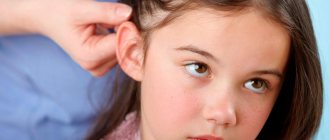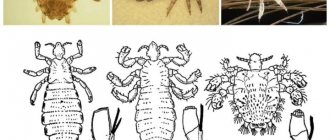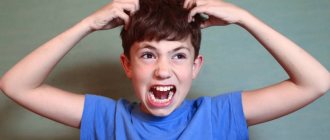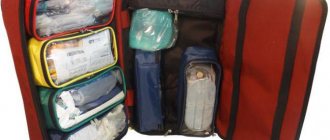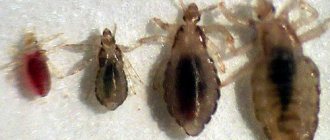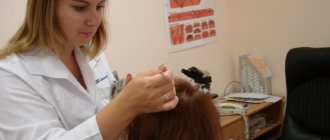Head lice
They are also called hair animals, as they live on the scalp. Characteristic signs of this type of lice:
- adult size – from 2 to 4 mm;
- color – gray-yellow;
- body is translucent.
The insect has three pairs of legs, with which they tightly grasp the hair.
The louse lives for about a month. Females lay 5–7 eggs per day. Lice eggs are nits. They are firmly attached to the hair at its very base and look like translucent round capsules. The larva develops in the egg within 7–10 days, after which an adult emerges from the egg. The eggs remain on the hair. It is impossible to distinguish an empty egg from a nit with the naked eye (for more details, see the article “How long does it take for lice to hatch”).
How dangerous is a head louse?
This type of lice is the “safest” for humans. They do not carry dangerous diseases like body or pubic diseases. But these parasites themselves are unpleasant. They have a powerful mouthparts with which they bite through the skin, causing micro-wounds to form into which the insect's saliva gets trapped, causing itching. Also, these wounds can become infected, which leads to the development of skin and other diseases.
Lice infestation is called pediculosis. Signs of lice:
- severe itching on the scalp - they live not only on the scalp, but also in the beard, eyebrows, mustache;
- bite marks;
- after scratching, crusts appear on the head;
- due to incessant itching, a person becomes nervous and restless;
- with severe damage, the lymph nodes swell.
There is an opinion that lice and nits appear in people who do not maintain hygiene or lead a specific lifestyle. In fact, anyone can get lice.
They are transmitted in different ways:
- in case of close contact with an infected person - less than 50 cm;
- through combs, hats, accessories;
- through bed linen;
- in the pool - a louse can live in water for up to two days.
One adult can reproduce many times within just a few days. When the next generations of lice lay eggs, the hair becomes tangled, tangles form in it, and an unpleasant odor appears. If at least one female remains alive during the fight against these parasites, she will continue to reproduce. With long and thick hair, treatment for head lice can be very lengthy.
Prevention of head lice
Pediculosis. Prevention and control measures
A.I. FROLOVA, Ph.D. biol. Sciences, Associate Professor Department of Disinfectology IPO First Moscow State Medical University named after. THEM. Sechenova, leading researcher of the department of scientific problems of disinsection of the Federal Budgetary Institution "Research Institute of Disinfectology" of Rospotrebnadzor, Moscow
Summer has arrived, which means a favorable season for the spread of lice. Let's consider what measures to prevent and control pediculosis.
Types of lice and their characteristics
There are three types of lice: head, body and pubic.
Head lice live and breed in the scalp, preferably on the temples, back of the head and crown. They feed every 2–3 hours. They do not tolerate hunger well; at +30 °C they usually die within a day. Development of eggs occurs within 5–9 days, larvae – 15–17 days. The lifespan of adults is 27–30 days. Females lay 3-7 eggs daily, and throughout their lives - from 38 to 140 eggs. They are very sensitive to changes in temperature and humidity, the optimum temperature is about +28 °C. When the temperature drops, development slows down; at +20 °C the female stops laying eggs, and the development of larvae stops. Outside the host's body, the louse dies within a day.
The body louse lives in the folds of linen and dresses, especially in the seams, where it lays eggs, gluing them to the fibers of the fabric. Eggs can also stick to hair on the human body, except the head. Eats 2–3 times a day; saturates in 3–10 minutes, drinks noticeably more blood at a time than the head. Lays about 10 eggs daily, during life on average about 200, with a maximum of 300. Eggs develop within 7–14 days, larvae – 14–18 days. The average lifespan of adults is 34 days, with a maximum of 46 days. The optimal development temperature for body lice is 2–4 °C higher than for head lice – 30–32 °C. At 25–30 °C they can fast for 2–3 days, and when the temperature drops to 10–20 °C they can fast for about a week. All stages of development, including the egg, are very sensitive to temperatures above +37 °C. Lice tolerate dry heat (47–50 °C) for up to 10 minutes and then die. Lice tolerate low temperatures and high humidity much better. At -13 °C they remain viable for up to 7 days, in water they remain alive for up to 2 days.
The negative relationship of lice to high temperatures is of epidemiological significance, since lice leave feverish patients and can crawl onto surrounding healthy people.
The pubic louse, or flat louse , is the smallest of human lice. With significant numbers, insects can spread over the entire lower part of the body, especially on the stomach, where, as a result of their blood-sucking, characteristic bluish marks remain for a long time. The pubic louse is inactive, usually remains in place, plunging its proboscis into the human skin, and drinks blood often with short breaks. Fecundity is low: the female lays no more than 50 eggs during her life. The eggs hatch into first-instar larvae, which later develop into second- and third-instar larvae. Each phase of larval development takes 5–7 days, and the female’s lifespan is about 1 month. Outside of humans, a living creature can only live for 10–12 hours.
Symptoms of lice
Symptoms of pediculosis are described as:
- Itching, accompanied by scratching and, in some people, allergies.
- Coarsening of the skin from massive lice bites and exposure to saliva.
- Melasma is skin pigmentation due to tissue hemorrhages and an inflammatory process caused by exposure to saliva.
- A tangle formed when scratching the scalp. The hair becomes tangled and sticks together with purulent-serous secretions, which dry out in crusts on the head, and underneath there is a weeping purulent surface. Koltun is a rather rare occurrence.
Pediculosis is often complicated by pyoderma. It develops due to the penetration of a secondary bacterial infection through skin lesions caused by scratching lice bites. With widespread pyoderma, regional lymphadenitis may be observed.
How does lice infection occur?
People can become infected with head and body lice through close contact with a person infected with lice. For example, when children communicate in groups (kindergartens, boarding schools, labor and recreation camps, etc.), as well as in crowded transport, in crowded places, in swimming pools and when using common objects - combs, hats, clothes , bedding, etc.
When infected with pubic lice (phthiriasis), the lice crawl from person to person mainly through intimate contact (95%). Less commonly, these insects can get on a person when washing in public baths, massage rooms, hotels through bedding.
In large cities, the prevalence of lice is higher. This is due both to the identification of patients when people go to sanitary checkpoints, and to social factors.
In Moscow, the incidence of head lice in adults is almost 8 times higher than the Russian average.
A large influx of migrants is rushing to the cities, some of whom become homeless. The proportion of this category of the population among those affected by pediculosis is extremely large. On average, about half a million homeless people are examined annually, with more than 7 thousand infected with head lice and more than 170 thousand infected with body lice. Consequently, being a risk group for pediculosis, homeless people become ill more often than other groups of the population and create uncontrolled foci of infection around themselves. This threatens outbreaks of diseases whose pathogens are transmitted by lice [2].
Lice as carriers of dangerous infections
The importance of human lice species as carriers of pathogens of infectious diseases varies. The greatest epidemiological danger is posed by body lice, whose role has been proven epidemiologically and experimentally. They are carriers of pathogens of epidemic typhus and relapsing fever, Volyn fever.
Lice, having drunk the blood of a patient containing pathogens of typhus or relapsing fever, after 4–7 days become capable of transmitting pathogens to a healthy person.
A person becomes infected with these diseases when secretions of infected lice get on the mucous membranes, in wounds in places of scratching, skin damage, or when an insect is crushed. Even if lice excrement gets on clothing, the risk of disease remains, since rickettsiae are viable and pathogenic for up to three months or more.
In relapsing typhus, the causative agent - a spirochete (Borrellia recurrentis) - enters the stomach of the lice with the blood of the patient, and then into the lymph. A person becomes infected from infected lice by crushing them, introducing spirochetes into the superficial areas of the skin when scratching or on the mucous membranes.
The head louse is currently considered as a possible carrier of the causative agents of epidemic typhus and relapsing fever. However, it is known that in the experiment, the infection of head lice with Provacek's rickettsia is 30% lower than that of body lice.
The pubic louse has virtually no epidemiological significance, however, just like body and head lice, it causes great concern to a person, causing severe itching. With strong scratching, various pustular skin diseases and exacerbation of dermatitis and eczema may occur.
Preventive and exterminatory measures to combat pediculosis
The fight against lice includes a complex of preventive and exterminatory measures.
Preventive measures include scheduled examinations of organized groups of the population, their sanitary treatment, compliance with the sanitary and anti-epidemic regime in organized groups, compliance with personal hygiene rules, and carrying out sanitary educational work among the population. In Appendix 1 we provide a reminder that you can use for sanitary education work.
The complex of extermination measures includes the simultaneous destruction of lice on the human body, underwear, clothing, bedding and in the home. Thus, measures to combat pediculosis are carried out not only for epidemiological, but also for sanitary indications.
It is prohibited to refuse hospitalization for the underlying disease due to detected lice.
Methods for killing lice
Disinsection measures to combat lice include three methods: mechanical, physical and chemical.
MECHANICAL METHOD
The mechanical method of exterminating head lice is recommended for pregnant and lactating women and children under five years of age, as well as children and adolescents who are sensitive to cosmetics or suffer from allergic diseases. The method involves combing out lice and eggs with a fine-toothed comb every 5–7 days or cutting the hair. To remove nits more easily, you should use 4.5–10% acetic acid or table vinegar in the same concentration for rinsing hair or applications.
PHYSICAL METHOD
The physical method - the use of low and high temperatures - is recommended for body lice to kill body lice.
When things and bedding are frozen in the cold for an hour from -13 °C, insects die and from -25 °C - lice eggs.
Boiling laundry and ironing things with a hot iron or treating clothes and bedding in disinfection chambers can destroy adult insects, larvae and lice eggs within 20–90 minutes, depending on the disinsection method.
CHEMICAL METHOD
The chemical method - the use of pediculicides - is still the main method for killing lice.
This method can be used to combat three types of lice (head, pubic and body lice), as well as for disinsection of premises in areas of lice. Chemical agents (pediculicides) are used in a variety of formulations: lotions, shampoos, insecticidal soaps, emulsion concentrates, and aerosol products.
Pediculicides should be used strictly in accordance with the label or instructions for use of the product. Basically, they are not approved for use by children under 5 years of age, pregnant and lactating women, as well as people prone to allergies and sensitive to cosmetics and medications.
Since pediculicides are cutaneous agents, there are limitations to their development and use. The range of compounds that can be used as active ingredients is limited: pyrethrins that do not contain a CN group, pyrethroids and organophosphorus compounds. They mainly use synthetic pyrethroids (permethrin, phenothrin, bioallethrin), as well as natural compounds - pyrethrins from extracts of Dalmatian or Caucasian chamomile. From the group of organophosphorus compounds – malathion (karbofos), fenthion. Solvents of active substances included in pediculicide formulations: water, alcohols (ethyl or isopropyl), deodorized and regular kerosene. The composition of the products also includes substances used as functional additives that increase the effectiveness of pediculicides or stabilize the formulation of the product.
Selection of pediculicides
To destroy head lice when treating scalp hair, various forms are used: emulsion concentrates, lotions, shampoos, soaps based on non-traditional insecticides, mixtures of pyrethroids and organophosphorus compounds (OPS).
Not all pediculicidal agents have an ovicidal effect (against nits). This mainly applies to forms such as insecticidal soaps and shampoos. When using products that have insufficient ovicidal effect, it is recommended to carry out repeated treatments after 7–10 days.
For phthiriasis (pubic louse), eyelashes, eyebrows, beard, armpits, pubis, and hairy parts of the legs are treated. To destroy this type of lice, almost all the same pediculicides are recommended as for the fight against head lice. However, treatment of phthiriasis should be carried out in a regional dermatovenerological clinic so as not to miss sexually transmitted diseases.
For body lice, underwear and bed linen, outerwear, and bedding are treated. Seams and folds are treated especially carefully, as these are favorite places for lice to lay eggs. To kill body lice, emulsion concentrates based on organophosphorus compounds or a mixture of FOS and permethrin are recommended.
For special contingents, means for impregnation (impregnation) of linen and things are recommended.
head (Pediculus humanus capitis De Geer) (Fig. 1),
Rice. 1. Head louse (female)
- Clothes (Fig. 2)
Rice. 2. Body louse (male)
- pubis (Phthyrus pubis L.) (Fig. 3).
Rice. 3. Pubic louse (female)
These types of lice can only feed on human blood, so they parasitize only on humans and you can only become infected with lice from people.
Infection of people with head and body lice can occur through close contact with a person suffering from lice - in crowded transport, in crowded places, in swimming pools, as well as through the use of shared objects - combs, hats, clothes, bedding, etc. .
When infected with pubic lice (phthiriasis), the lice crawl from person to person mainly through intimate contact (95%), less often, these insects can get on a person when washing in public baths, in massage rooms, hotels through bed linen.
The favorite habitats of head lice are the temporo-occipital part of the head (Fig. 4). When the number of insects is high, lice spread throughout the entire scalp.
Rice. 4. Lice eggs (nits) laid on the hair
The habitats of pubic lice are eyelashes, eyebrows, mustaches, beards, pubis, and armpit hair.
Head and pubic lice lay eggs on the hair, attaching them with an adhesive substance secreted by the females (Figure 5).
Rice. 5. Nits (enlarged)
Body lice live mainly in the folds of linen and clothing (especially in the seams), where the females lay eggs (nits), attaching them to the fibers of the fabric with the help of an adhesive substance secreted by them.
When lice suck blood, they secrete a specific substance that prevents blood clotting and causes severe itching, which leads to scratching of the skin, which can lead to dermatitis or eczema.
Body lice are especially dangerous, since they can be carriers of pathogens that cause epidemic typhus, relapsing fever, and Volyn fever.
To prevent lice infection, the main thing is to avoid contact with people infected with lice and observe the rules of personal hygiene: comb your hair thoroughly every day and cut it in a timely manner, if possible, wash daily, change underwear and bed linen as they become dirty, but at least every 7-10 days .
Children should be examined regularly, especially if the child attends kindergarten or school. Particular attention is paid to the occipital and temporal parts of the head. The most obvious sign of lice is the presence of white lumps of nits at the roots of the hair or combed wounds on the scalp caused by lice sucking blood.
For head lice, if a small number of head lice are found (from 1 to 5 insects) that have not yet had time to lay eggs (nits), you can use a fine-toothed comb to comb the lice out of the hair; If the number of body lice is small, the linen can be boiled and outer clothing can be ironed with a hot iron. Especially seams and folds.
In cases where insects have already laid eggs, it is recommended to use special insecticidal agents - pediculicides - designed to kill lice.
Be healthy !!!!
Body lice
This species does not live on the human body. It lives and hides in the folds of clothing and bedding, which is why the fight against this type of lice is especially difficult and long.
This type of lice has a translucent body measuring 3–5 mm; they are dirty white in color and darken when saturated with blood. In terms of lifestyle, they are more reminiscent of bed bugs, since most of the time they hide in clothes or bedding and can make their way into the thickness of mattresses, pillows, and blankets. This is where the eggs are laid. They do not live directly on human skin or hair, but go there only to feed. Bites most often appear on the upper body - neck, shoulders, back and lower back.
A body louse - or as it is also called, a linen louse - lives for about 35 days, the female can live up to 45 days. During her life cycle, the female lays about 300 eggs. Development to adulthood takes no more than a week.
Infection with body lice occurs much less frequently than with head lice. It is often associated with an antisocial lifestyle, poor hygiene and a rare change of clothes and bed linen.
You can become infected with body lice:
- when trying on clothes;
- when wearing clothes of a sick person;
- when sleeping in a bed infested with lice;
- in crowded places with close contact with the carrier.
Linen lice also cause lice, just like head lice. This is expressed by bites, and they are not in the form of punctures of the skin, but lice can cut off micro-pieces of skin with their jaws. These bites take 4 or more days to heal. At the same time, they itch very much. The parasites' saliva causes hives. It contains a secretion that prevents blood clotting. With severe damage, body temperature rises.
Since linen lice can move from one person to another, they can also carry pathogens of dangerous diseases, such as typhus, etc.
Diagnostics
Establishing a diagnosis is not difficult. It will be quite enough to collect an anamnesis and examine the affected areas of the body and scalp. In some cases, lice are visible to the naked eye; they can be distinguished especially well when they drink blood. You can also use a Wood's lamp and a magnifying glass. Live nits and parasites glow blue or white, while empty eggs have a gray tint. It is extremely rare that digital videoscopy is required to confirm the diagnosis.
Differential diagnosis of pediculosis is carried out with vulgar impetigo and scabies.
Pubic lice
This is the third option of what kind of lice a person can have. They live on the hairline, but not on the head, but in the groin and armpits. They are attracted to these places by the secretion secreted by the apocrine glands.
These pests are smaller in size than body or head pests. Their length is only 1.5 mm. The body is light brown, flat, not elongated, like other types of lice, but more round. Their paws are designed to move along hairs with a triangular rather than circular cross-section.
The pubic louse feeds every 4 to 5 hours, so bites when infected with this type of lice are multiple.
The peculiarity of pubic lice - also called flat lice - is that they lay eggs at temperatures from 20 to 40 degrees. At higher or lower temperatures, they cannot breed. The human body temperature is ideal for them.
They cannot live outside the hairline, so the simplest way to combat them is to completely shave off the hair.
Infestation with pubic lice is also pediculosis, but its special type is phthiriasis.
Signs of phthiriasis:
- severe itching;
- bite marks, blisters and small hemorrhages in their place;
- traces of parasite activity on underwear.
Representatives of this type of lice also live for about a month. During her life, the female lays about 300 eggs.
In addition to the discomfort that pubic lice cause, they can be carriers of sexually transmitted diseases. They carry syphilis, gonorrhea, chlamydia, etc.
You can become infected with this type of lice:
- during sexual intercourse with a carrier;
- just in close contact;
- when wearing clothes of a sick person and using his personal belongings;
- in common areas - swimming pools, baths, saunas, solariums, public restrooms, etc.
Symptoms of pubic lice
The symptoms of pubic parasites are very similar to the symptoms of head lice:
- • severe itching in the groin area;
- • the appearance of spots and inflammation at the site of bites;
- • redness, burning sensation and swelling;
- • presence of nits;
- • increased irritability, poor sleep
Itching in the infected person usually makes one suspect lice infestation. A thorough examination of the scalp with combing over a light cloth will allow you to finally understand and verify the presence of lice.
Head and body lice can spread quickly in crowded places - children's institutions, dormitories, military barracks, correctional facilities.
What other types of lice are there?
As mentioned above, each type of lice lives only on “its” victim. In addition to human lice, people have to deal with pests on their pets. Lice eaters live on dogs and cats. Their difference from human lice is that lice eaters do not feed on blood, but on dead skin flakes and animal hair. In terms of symptoms, lice-eater infestation is similar to human lice. It is also expressed by severe itching. Lice eaters do not spread from pets to humans.
Lice don't just live on cats and dogs. They can live on mice and rats, sheep, horses, pigs and other animals. All types of lice have the same structure. Vary in size. The largest are pork hematopins, whose length reaches 5 mm. And the smallest are hoplopleurae, which infect hamsters whose size does not exceed 1 mm. Also, species can differ in color, although they are all brown-gray, and when saturated with blood they darken to black.
All types of lice have the same nits - capsules in which the larvae develop. They are round and translucent, attached with an adhesive substance to the base of the hairs.
Types of human lice
There are two morphotypes of human lice found in nature – head and body lice. Additionally, pubic louse stands out. The above morphotypes are believed to be derived from a single parasite species. According to scientists, the division occurred from 30 to 114 thousand years ago. In addition to having one ancestor, lice morphotypes have a number of interesting features:
- • do not produce offspring in natural conditions;
- • are easily crossed in the laboratory;
- • one morphotype can transform into another
Thus, it takes no more than 3-4 generations to transform a head louse into a body louse, if the insect is transplanted onto clothing and conditions are created for breeding offspring. The same scheme works the other way around - if you keep a body louse on your head, after a couple of generations the morphotype will change. We propose right now to consider the existing types of lice in humans in more detail.
How to deal with all types of lice
Traditional methods of control can only work in the initial stages of infection, when there are not very many pests yet. For treatment, essential oils with pungent odors are used, as well as cranberry juice and vinegar. They make wraps with these products, wash their hair with them, and treat the skin. Another method is temperature. It is believed that lice die at -8 degrees.
But in case of severe infection, such methods are useless. You should use professional and effective pediculicides, for example, Medilis-BIO, Medilis-Permifen, Medilis-Malathion. They are used to treat the hair and skin of adults and children, as well as clothing and bedding.
Pubic louse
The second type of insects that parasitize humans. Habitat: pubic hair, genital and anal hair, hairy parts of the chest and abdomen, as well as armpits. In other words, pubic lice live on all hair except the head. This is due to the fact that the legs of these parasites are adapted for hair with a triangular cross-section.
The pubic louse differs from the head louse in its shorter and wider body. Males are about 1 mm long, females are 1.5-2 times longer. They have a characteristic and almost flat translucent body, which after feeding acquires a purple tint. There are three pairs of legs and a pronounced head.
Treatment of pediculosis
In modern pharmacology, there are a number of pharmaceutical products that are an effective measure to combat dangerous parasites. Timely identification of the problem is the beginning of the path to full recovery, but an integrated approach is required on the part of the patient. Effective treatment of head lice involves the following direction, which you need to choose with your doctor and make it a daily routine for the next 1-2 weeks:
- proper nutrition, intake of vitamins;
- timely identification of secondary diseases;
- use of pharmaceutical products in the form of shampoos, balms, hair masks;
- short haircut for the child (individually by decision of the parents);
- treatment of the head with folk remedies;
- prolonged use of a comb to comb hair;
- implementation of preventive measures;
- the need to examine not only the foci of pathology, but also things with their subsequent washing and ironing with a good hot iron.
Drugs
If a source of pathology is detected, lice prevention becomes ineffective. When infected, there is an urgent need for timely treatment of head lice with drugs against parasites. The effectiveness of such intensive therapy is high if you first consult with your doctor or at least carefully study the instructions for use. To exterminate harmful parasites, it is appropriate to prescribe the following medications:
- Gardnerella in men - symptoms and treatment regimen
- How to store lychee at home. How long and where should lychee be stored?
- What to do to lose weight on your arms and shoulders
Ointment
After a one-time use of these drugs, all that remains is to comb your hair using a special comb, and carry out this procedure for several days - in the morning and in the evening after examining the head. No less effective is the ointment against pediculosis, which can also be purchased at the pharmacy. Use separately from other drugs, follow all instructions from the instructions. The following medicinal ointments have proven themselves well:
- Benzyl benzoate;
- Permethrin ointment;
- Boric ointment.
Dust soap
To exterminate pathogenic flora, people have been using dust soap to wash their hair since ancient times. Parasites slow down their development under the influence of the chemical composition of this product, stop reproducing and die. This measure of combating harmful insects in modern pharmacology is outdated; it is better to use dust soap for the purpose of effective prevention, nothing more.
Folk remedies for lice
Measures to combat pediculosis can be not only official, but also alternative. Folk remedies for lice provide significant prevention, and are much cheaper than pharmacy shampoos, sprays and ointments. It is also possible to produce an effective remedy for head lice at home; the main thing is to choose a reliable, effective and safe recipe for all occasions. This can be a solution or medicinal ointment to suppress pathogenic flora and prevent re-infection. Here are some good recipes:
- Geranium oil, as a reliable means of combating head lice, can be dissolved in a small amount of regular shampoo. Treat hair with the prepared mixture and leave for 10 minutes under a thick layer of polyethylene. Wash your hair, dry it, and conduct a thorough inspection of the parasites.
- Grind a handful of fresh cranberries in one container and squeeze out the juice. Combine it with honey and mix the prepared solution thoroughly. Rub vigorously into the head and leave on hair for 20-30 minutes. This is not only a reliable measure of pest control, but also an equally reliable prevention of a typical disease.
- You can rub concentrated pomegranate juice into your scalp twice a day and leave the mask on for 30-40 minutes. After completing the procedure, inspect the head, comb out dead lice and their eggs with a comb.
Pediculosis pubis
Phthiriasis (pediculosis pubis) is a parasitic venereal skin disease. The pubic louse is located in the genital area and armpits. Much less often, parasites choose the area of the abdomen, chest or head. As a rule, the cause of lice pubis is close sexual contact, but cases of transmission through bedding or personal hygiene items are possible.
The incubation period of the disease lasts about a month. Only a few weeks after infection do the first symptoms appear, which are also characteristic of other types of lice - itching of the skin.
In addition, signs of phthiriasis are quickly disappearing bluish spots on the skin (like a small bruise). Intense scratching can lead to secondary infection and skin diseases. A feature of pediculosis pubis is that the parasites, affecting the genital part of the patient, violate the natural barrier that prevents infection from penetrating the genitals. That is why the patient is strongly recommended to be examined for sexually transmitted diseases.
It must be remembered that lice pubis is transmitted mainly through sexual contact, so both partners must undergo treatment.
Head lice
The source of the disease is hair lice that parasitize the scalp. The insects are white or gray in color and their size reaches three millimeters. The eggs laid by females (0.5 mm) are yellowish-white and tightly attached to the hair. It is impossible to shake them off, and it is not so easy to remove them; if you try to crush a nit, you will hear a characteristic crunch.
The main location of head lice is the occipital and temporal parts, as well as the places behind the ears. A visual examination of the head reveals areas of skin affected by bites, covered with yellow crusts. In advanced cases, furunculosis, a pustular rash forms, and the hair on the head sticks together. If head lice is not treated for a long time, complications may occur in the form of inflammation of the lymph nodes in the neck and behind the ears.
Head lice is the most common. Children under 15 years of age are mainly at risk. When visiting kindergartens, schools, or having close contact with each other, there is a huge chance of becoming infected with parasites. About 3% of schoolchildren are infected with hair lice, but there are underdeveloped countries where this figure reaches 15%.
Lifestyle
Pubic lice feed on human blood by biting through the skin with a powerful jaw apparatus. Approaches to feeding approximately once every 5 hours, so the activity of insects is accompanied by the appearance of many bite marks on the skin. The maximum time of hunger is 24 hours.
The presence of body hair is important for parasites, so one of the measures to combat insects is the complete removal of hair in infected areas. Also, environmental temperature is more important for the life and reproduction of lice. Comfortable range – from +20 to +40°C.
